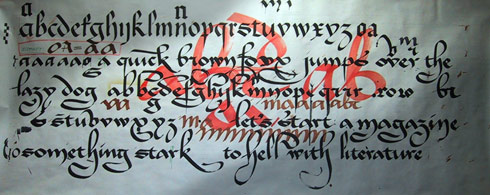Notable Quotes on Lloyd Reynolds
and the Reed Calligraphy Course
The following is a collection of quotes from interviews and Reed magazine articles.
Steve Jobs on calligraphy at Reed
Read the Smithsonian article on Steve Jobs, where he mentions studying calligraphy at Reed.
Steve Job's Commencement Speech at Stanford in 2005 references calligraphy
Meeting Lloyd Reynolds
I met Lloyd through a mutual friend who is the librarian at Portland State Library, and she would have had Lloyd in his first teaching experience at the University of Oregon. She made the connection for me, and we wrote back and forth and corresponded until finally he invited me to visit his home and a national handwriting competition. I arrived on campus, he turned around, and I saw this gray-haired man with a gray beard, and he looked around, said, “Bill!” and I said “Lloyd!” and we hugged. And I spent the weekend at his home and I never left, basically, for the following eight years. I had a room upstairs—I adopted him.
I came to Reed and I couldn’t read my lecture notes, and I wandered down to the bookstore and they had this wonderful book and a bunch of pens and this guy named “Lloyd” who was doing this, and so, all of a sudden, my lecture notes got very good, and I hunted up the guy who did it, and in the course of four years Lloyd changed my outlook, my major, and my technique.
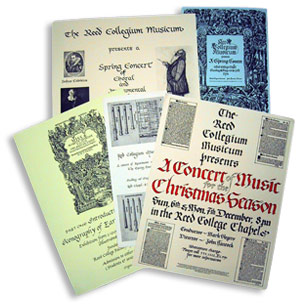 I remember the first encounter very well, which was watching him. I didn’t know what I was getting into. I signed up because it said “art,” and I always drew—I made posters. So, I was just astonished to see letters to be made with the one-inch wide callig pen, these great big black letters, completely harmonious and controlled.
I remember the first encounter very well, which was watching him. I didn’t know what I was getting into. I signed up because it said “art,” and I always drew—I made posters. So, I was just astonished to see letters to be made with the one-inch wide callig pen, these great big black letters, completely harmonious and controlled.
When in high school, I first saw an example of one of Lloyd’s student’s work, I had to find out where they’d learned to do it and then set on my goal that I was coming to Reed, no matter what, because I needed to study with this guy and I needed to understand where that came from.
I was majoring in it, because I was so good at it, and so I went over to the table where art majors sign up and, of course, I was the only one, I believe. And I didn’t know who this person was, but it was Lloyd, and he just signed people up. He put me down what I was going to take. So of course I had to take humanities and I had to take his course, and then I guess I had some other choices, but not much, and I thought “well, okay.”
I came over to Reed to take a class in his graphic arts class that was in Eliot 314 then. And as soon as we got into uncials and half uncials—and chancery cursive was introduced pretty early, the alphabets were very seductive—and I went for it. But I was also very interested in typography and there was a good type shop here, so I spent way too much time in 314 between ’52 and ’55. Too much time for my other academic work.
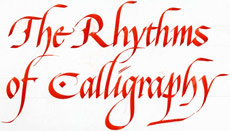 I was a freshman shopping around, trying to identify who all the great teachers were here, and everyone told me about Reynolds. So I went to his class in art history, just sat in on it. The first thing I noticed was that it was absolutely packed, standing room only, so I figured he must be doing something right. But, he was absolutely castigating everyone in the class. He was reading their essays and handing them back saying, “You don’t understand anything I’m talking about.” He said to everyone something that really sunk in. I didn’t know what he was talking about either, so I felt equally castigated. He said that “for every hour I spend up here yammering at you, you ought to be spending at least two hours doing life drawing or something.”
I was a freshman shopping around, trying to identify who all the great teachers were here, and everyone told me about Reynolds. So I went to his class in art history, just sat in on it. The first thing I noticed was that it was absolutely packed, standing room only, so I figured he must be doing something right. But, he was absolutely castigating everyone in the class. He was reading their essays and handing them back saying, “You don’t understand anything I’m talking about.” He said to everyone something that really sunk in. I didn’t know what he was talking about either, so I felt equally castigated. He said that “for every hour I spend up here yammering at you, you ought to be spending at least two hours doing life drawing or something.”
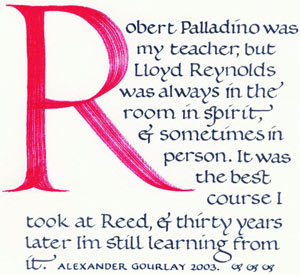
Teaching Experience
The meditative quiet with which Mr. Palladino approached each and every letter was remarkable . . . Robert Palladino's teaching, scholarship, and devotion to the handwritten letter have been guideposts to me for 30 years.
Thanks, Robert Palladino, for encouragement, craftsmanship, discipline, wonder, respect for the heritage of calligraphyand for sending me on this journey.
I met Robert Palladino, whose presence worked to impart the dignity that arises from erudition and personal discipline. He conveyed the joy and challenge of doing work well. Lloyd Reynolds' models and influence pervaded the calligraphy studio and I later studied with him . . . The wisdom of these teachers, born of decades of spiritual practice, continues to inspire me.
Reed College at that time offered perhaps the best calligraphy instruction in the country. Throughout the campus every poster, every label on every drawer, was beautifully hand calligraphed. Because I had dropped out and didn’t have to take normal classes, I decided to take a calligraphy class to learn how to do this. I learned about serif and sans serif typefaces, about varying the amount of space between different letter combinations, about what makes great typography great. It was beautiful, historical, artistically subtle in a way that science can’t capture, and I found it fascinating.
It wasn’t about calligraphy to me as a studentit was about an entire approach to education itself. It was a life-changing, mind-altering, psychedlic experience . . . Lloyd Reynolds was just a guy who could make you see, make you understand . . . He’d jump from Michelangelo to William Blake to Zen Buddhism effortlessly, and it all made sense.”
What I gained from [Reynolds'] class was a clear sense of the magical nature of making letters, and the fact that they are a true link between the mind and the body, between the physical world and the mental world.
What I remember is that he made me fall in love with the study of calligraphy, and that made me fall in love with the study of everything. It was an incredible invitation to get involved in a life of the mind.
Reynolds was an incredibly charismatic teacher and his interests were somewhat broader than the traditional academic program of Reed at that time . . . The classes were a window on the relationshiop between visual arts and culture in a very broad sense.
I took every class he taughtcalligraphy, art, creative writing, Zen Buddhism. He was the only professor who taught me anything.
In the course of four years, Lloyd changed my outlook, my major, and my technique.
With felt pens squeaking across vast sheets of butcher paper mounted on an easel before us, Lloyd moved with ease through the evolution of 2,000 years of western letterforms. His speech was audacious. The intricacy of information imparted through his demonstration and accompanying commentary was exciting and seductive, all of it delivered in his inimitable style, a dazzling performance of insights . . . Through the course of a single hour, Lloyd was able to take more facts and ideas than most individuals contemplate in a lifetime and wind them into an interconnected and complex web of fascination. This was his natural pace . . .
The graphics arts class . . . was basically the history of the world through calligraphy as a prism.
Lloyd had the ability, magical, to make every person, at least all the people I knew, feel that they were the most important person in the room. I don’t feel that he had bunch of special disciples that got special treatment, at least I never felt that way. He made me feel special . . . You are the one, you are the one, you are the onehe could do that to a whole room full of people. And when he would lecture he would look at you and you were it and you knew the whole talk was for you. It was just a magical ability.
It was just a wonderful form of procrastination to not do my other work at Reed. And it was an accessible art form to me. You know, it was something that you could learn the rules relatively quickly and anybody could learn them. It wasn’t something that took a great talent to learn these skills and so all ordinary people could come up with a decent hand.
All the way from school, I mean, I can remember being a pain in the . . . as far as the teachers were concerned. Opening my mouth and asking questions that they did not appreciate, that they didn’t have an answer for, therefore they really didn’t want me to ask. Lloyd never objected to those. He always encouraged me. He frequently didn’t have the answer either, but he would give me an idea of what to read and where to go to find it and how to research it on my own. And, he would also go and look himself, too.
I took the beginning class. It was Italic and it was, I don’t know, it was a magical experience. It’s affected my whole life, but it was a short, you know, it was not a very long, intense thing that I went through with him, it was just a short, intense thing.
He’d walk into a classroom, and the students are busy. They’re warming up and getting ready. And then he’d walk to the board and he’d make an “E.” And then, he’d turn around. That was a wonderful entrance. And everybody had stopped and was following him standing there. And he wouldn’t say anything. He wouldn’t say anything, and then he’d turn and make an “F” . . . more time . . . and then he’d say “why does that cross bar on this F have to be?” And, they were going, they were just sucked in . . . they were right on the edge of their chairs, man! They were absolutely enthralled of what in the world he just did. It was the most wonderful thing . . . It was an incarnation right in front of their eyes. The guy wrote an “E,” and an “F,” and there wastheatre here.
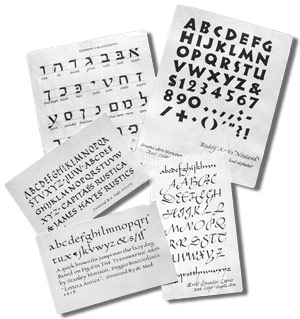 He would start talking about a particular typeface or a particular calligraphic style that was the topic of that class, and, of course, the digressions would build on the digressions, and he’d get around to the closure, and by the end he was practically giggling. And everyone in the class was having a minor satori. There was a break, and then you would come back and start working. He would do a demonstration as well on the board and explain each stroke and what the sequence was and why it was important that you do it in that sequence. And then people would spend the other two or three hoursit was a long classjust working at their spot or their space on the table, and he would walk around and look at people’s work and make suggestions.
He would start talking about a particular typeface or a particular calligraphic style that was the topic of that class, and, of course, the digressions would build on the digressions, and he’d get around to the closure, and by the end he was practically giggling. And everyone in the class was having a minor satori. There was a break, and then you would come back and start working. He would do a demonstration as well on the board and explain each stroke and what the sequence was and why it was important that you do it in that sequence. And then people would spend the other two or three hoursit was a long classjust working at their spot or their space on the table, and he would walk around and look at people’s work and make suggestions.
I was with him for seven years taking the same class over again, seven years at the art museum; and every year I thought I would know what he was going to say, and every year it was different. He, essentially, he said the same things, basically, but he said them differently. And he continued to grow and to change and adapt himself to the particular audience he might have had. He could talk to you on this level, this level, this level, or talk to children and kiddies, whoever he was with he gave that same feeling to. And, I don’t think you can take it apart any more than can really take apart a poem. He just . . . was.
I heard one story where he reduced the woman to tears. He told her that she didn’t have an ounce of rhythm in her body and that she needed to go home, put down her pen, go home, take off her shoes, and put on Mozart and dance around the room. She started crying, and he felt awful at that time. I heard that he sent her Christmas cards every year.
I remember one time [Lloyd] told me I should stand that—whatever letter it was—in the corner. He had a very strange way of telling you that you had created an abomination of a letter. I should go stand that letter in the corner.
[Lloyd] had an astonishing memory. He read all the time and very widely, and then he was able to access it at any time. And, he accessed it in poetry practically. I mean, he was a minor poet, or a major poet, whatever you want to say. But he was eloquent. And eloquence for language types, for word types like we were at Reed . . .
By the time I got around to calligraphy, it was just because I was madly in love with Lloyd. I don’t think anybody could be in the same room with him for 10 minutes without being madly in love with him.
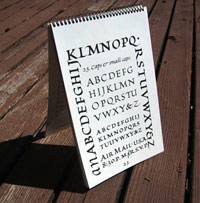 Graphic Arts Workshop
Graphic Arts Workshop
I was here before Lloyd set up his workshop. He had his thing at home but not on campus that I knew of. And invited all kinds of people, not just students. Faculty, faculty wives, husbands, whoever, to come. What comes to my mind, I remember a poster one time about a workshop that he was going to teach and it said “Workshop will start.” They forgot the K. Really. Lloyd was a phenomenon himself. I think he could have taught stuffing butterflies, and by now we’d all be butterfly stuffers.
I don’t remember ever even knowing Lloyd till I took that workshop. But then it also provided a community. There were other folks who were taking this workshop and who loved it, too. And a bunch of us who made the signs compared notes, and so it became a community. I mostly just remember making signs, printing announcements and working up there long into the night and having the fun of your friends coming in and out and doing their stuff too. And Lloyd passing through and saying “yes, that’s good” or “hummmm, why don’t you do this instead.”
For God's sake, don’t try to invent your own alphabet! I’m certain that he was not opposed to more sophisticated kinds of letter design, but it would be after 10 or 12 years if you were good.
I remember that we had tilted boards. And I remember that we had to rule the paper very carefully. And I remember, more than once, spending the entire three hours of that workshop—which I looked forward to so much for the writing—ruling the lines until they were right.
By the time I entered in ’57, there were so many people that wanted to take the graphic arts workshop that as a freshman I was not permitted to enroll, because there were so many already who had already preregistered from the previous freshman class. He did open the lab on Saturdays. I mean he was there six days a week, sometimes seven. And he was always there on Saturdays, and he had an open lab.
I think that it is probably true for a lot of Reed students, at least at that time, that you really felt very insecure in the academic pursuits. I was surrounded by people from Phillips Exeter and other prep schools who were much better prepared for scholarly work than I was. So the workshop was kind of a haven, or a hideout place to escape the toughness of the academic world. It was not that I didn’t care for the academic work, but if you’re given—or if you have a tendency or a desire to make an object, to make an object rather than manipulate an idea, there’s no real substitute for that. And, it was really the making of objects—whether they are letter forms or lines of type or broadsides or printed books, the making of the object that had great appeal. And you could do those things in a workshop and it would seem like it was always open.
It was opened 24 hours a day. You want to do a poster for the commons? You just went up there and laid out some butcher paper and you put a little bit of money in the can that paid for the paper and you rolled your thing out, and you took it down, you put it up, and you hung the water balloons, and you went away.
[We were] watching Lloyd’s public television show on calligraphy. When he was doing ampersands he’d do one and he’d go “Wooooow!” He’d groan. We’d roll that tape back, reverse it, and look. I said “That guy is groaning! He’s having an experience here with this ampersand! I can’t believe it!”
Well, [in the 60s the lab] was a building out there somewhere, it looked like something leftover barracks or something. And the floors creaked a lot and there was a big letterpress. When you first walked in the studio there was a letterpress. You walked through this area, a couple of tables.
The graphic arts lab that they moved to [in ’60s]—there was something just not right about it. Before that it was like Hogwarts—we were in this magical place, up on the back of the Eliot building, practicing this magical skill that only the initiated knew about, and it was just wonderful, a warm sort of sharing thing. And things that you did with your fingertips—magical little toys, and types being brought out of drawers.
The first semester we did the history of writing from the beginning, and we did every one almost. The second semester was the history of the book, and at the end of the first semester you should write a handmade book. I made a handwritten book of a Dylan Thomas’ short story and somebody swiped it. But anyway, the second semester was the history of printing and the book, and we were to end up with a printed book.
The thing about what he told us is that I always felt like I knew he was right; I just couldn’t see it. A year or two later, after quitting and giving it up, and then through some pure accident having the responsibility to do some work, saying “Oh God, I never did learn the numerals and now I have to do something that has numerals in it.” And then you’d practice and learn them, but then you would see something and you’d say "That’s what he meant when he said ‘never look at the stroke you’re making, only look at the counter form.”’ Well, that’s easy to say, it makes total sense, but to actually do it is really hard. But as soon as you understand that, you know it emotionally and tactically. You can attribute it to him and rightly so.
He quoted William Morris saying, “The true secret of happiness lies in the taking of genuine interest in the details of daily life and elevating them like art.” And so, that’s why calligraphy, why Italic handwriting, is not as an art form to hang on a museum wall (he used to say museums are mausoleums for dead art) and that the art of daily life was what was important. He talked about gothic workers being wedded to craft as well as to the piling of the stones—they weren’t just stonemasons; the same people who built the cathedrals were the ones who carved the gargoyles. And, he talked often about how that got destroyed in the Renaissance when the idea of individual creative genius came about and separated the worker from the hands-on work.
He said, “I almost thought of pottery. It’s the vehicle between the teacher and the student.” And so, letter, penmanship, or letters . . . that became the vehicle. He said it could have been pottery . . . Everybody writes, most people write. Most people don’t throw pots or work with clay. But, they can get every man’s art, calligraphy.
We were sitting there talking, and I was working on some scholarly articles on Renaissance scribes, and we were doing all this very scholarly stuff, and he was showing me some samples of some of these people in Portland who were exemplifying that. And, I made some comment about, “But they’re not in scholarship anymore. These are housewives and more ordinary people. Good hands, but . . . ” “Oh,” he said, “don’t you ever say that! Mere housewives are greater than you by far! Look at that what they do, and what do you think their attitudes are?” And I thought, oh dear, did I step into that one.
The creativity is there for the taking because every person is an artist. In one of the quotes I found when I went back through my notes [from Lloyd’s class], he quoted Kumar Swami saying, “The artist is not a special kind of man. Every man is a special kind of artist.”
I think it’s because language is so important to human beings that when someone has power in language, and Lloyd had it visually as well as in its eloquencehat’s powerful stuff.
There is something in calligraphy that lends itself. Because like Arnold Bank had disciples. Ray Daboll had disciples. Edward Johnston had disciples. People bowed at his feet and worshipped him and loved him. I mean, there is something when you start finding letter forms and you get the magic in you; it transmits, and people just go crazy.
I think that that whole image of him first doing his kind of philosophical ramblings mixed in with the teaching, that’s one of my biggest memories of his teaching style, all of that wonderful poetry and philosophy and Zen Buddhism that he would kind of eclectically throw out and get your mind going. Ohhhhhh. You know. But then, we’d have the sitting down and doing the nuts and bolts part of it, and he was rigorous. But, my perception of it is was the craft demands a certain rigor. I didn’t ever feel that it was personal.
I think that he continued to grow till the day he died. But he certainly was able to put all these things across even in the ’40’s. And I think most of us didn’t dare miss a class because that might be the one when the real secret came together.
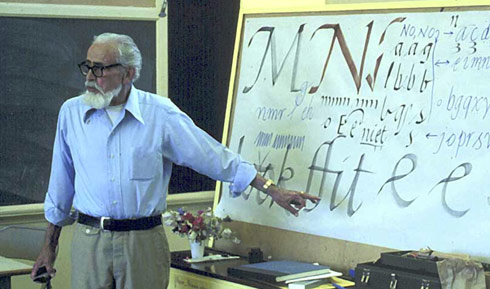
Reynold’s Philosophy
Of influences that changed me at Reed, Lloyd Reynolds, both as a teacher of creative writing and as a calligrapher and typographer, was surely the most radical . . .
He knew so much of all the religious texts and he had so much respect for them that he would, within a five minute period, he would quote the Upahishad, and he would quote the Tao, he would quote Mao Tse Tung possibly, and he would quote the Old Testament and the New Testament, practically in the same paragraph.
[Lloyd] said, “The only way to keep our culture from continuing its present disintegration is to seek larger unities, learn to count to one.”
The path of virtue is to be direct. Do not try to get fancy. The fundamental forms will be so beautiful if you do them well that you do not need to worry about making them better—at least in the beginning. Don’t retouch, because the tendency to retouch when you start out is to try to fix bad lining which never works. You can eliminate glitches, but usually when you start you think you can fix it. No. Just start over again.
He never got on anybody’s case that I know of, directly, but he was always very good at pointing out the things you should avoid. And how others had done wrong. Oscar Ogg, very bad. So, the student got a very clear picture of the path of virtue.
Chuck Bigelow [‘67] has referred to him as a “Puritan evangelist.” That is, there was a path of virtue but he had the Burt Lancaster treatment of Elmer Gantry, of enormous charm, terrific energy, and enthusiasm, and it was irresistible. It was pretty much irresistible, whether you were male or female . . . He was dedicated to bringing the word and the truth and democratizing this whole thing of handwriting. I mean, I’m sure that that was at the heart of his interest in calligraphy at this school. This could be for everyone. He was an egalitarian, and I could certainly see why he bridled at the idea that housewives or people who didn’t work professionally were somehow of less significance.
I think his will to bring things together, to synthesize ideas, often kind of overwhelmed his sources in a way. You know, it was amazing, he would start to talk about William Morris and you’d get all really excited, and then you’d go read William Morris and, boy, where was the magic? . . . I think it was how he saw Blake through Zen Buddhism, through Taoism and through kind of his experience of life, and it became something more than just the sources. He wasn’t a rigorous thinker. He was a Joseph Campbell type, who took what he needed in order to communicate what was useful to him, and useful to his life, and also to his practice. I think the practice, in both senses, doing the learning and discipline, and also the practice in terms of actually making stuff.
I don’t remember that it was Morris, but it was one of the people that he was raving about and I went to the source, and in going through it I found like 50 pages apart, the first two things that he’d made reference to, and then another 200 pages later, the third one. He’d somehow or another skipped all the boring, horrible stuff in between. He just was picking out these gems and stringing them together. What Lloyd’s doing is making the connections instead of all those boring pages in between. It wasn’t that what he was doing was so inaccurate and so non-true to the source, it's that he’s always getting from one point to the next.
One of his sayings that he used to say often was, I think it was a Chinese saying, “Heavenly breath moving rhythmically creates life spirit.” creates chi, life spirit, or life movement. And so the idea of the movement through a person, then coming out in the hand and in the dance, the hand on the paper, and you see that movement in calligraphy unlike seeing stamped letters. He liked graphic arts also, you know, of printed word, but he was enchanted with the handwritten form because you could see the movement of life in the work.
This was his autobiography. He rolled this thing out: I inhale, I exhale, hallelujah! Just break it all down to the basic, breath out, breath in, and stop fretting about all the rest of this stuff.
He talked about light, a lot and the function of light. One of the notes I took said, "talked about Santa Claus." And then, after Santa Claus I wrote, “The sun god comes through the sun door on the longest day of the year with the promise of renewed light.” That’s Santa Claus, okay? And then right after that, “The light by which one can see the sun is brighter than the sun.” So these were the kind of things that were dripping between “this is the right counter that you have to do for an ‘A’ and you have to arch your ‘N’ this way." You know, all this other stuff is just pouring out. The other one that he used to tell us was to go and look at the spaces between the blades of grass. You don’t look at the grass, you look at the spaces between the blades of grass. And that was a very practical piece of advice for calligraphy; it wasn’t just about some kind of Zen thing of looking at the world a different way. It was about looking at how lines on pages create spaces rather than looking at the line. So everything tied back in. It was often a metaphor for what we were doing. It was a metaphor for the Italic or the handwriting that we were doing.
I can remember him saying that if when you look at a work of art a light doesn’t go on, it’s not really a work of art. That somehow there should be this almost spiritual connection when you look at the thing . . . And, I think any of us wandering through the acres of canvas and tons of oil paint in the museums of the world, if one comes upon a Singer Sargeant with a white dress that she just stands there and WOW! It’s sunlight ripples, and that’s what he wanted you to find.
One of the things I found in my notes, for example—this is kind of a Joseph Campbell approach—he was talking about the symbol of the thunderbolt, and the thunderbolt annihilates and illuminates simultaneously so you can understand a thing like that. And then he showed—and I copied down in my notes—the Greek form of a thunderbolt, the Tibetan form of the thunderbolt, the French symbol for a thunderbolt, you know, and that kind of thing. I mean, it was exciting to just be around that eclectic kind of mind. My impression would be that he had a belief in kind of a Jungian universal consciousness that pervades all of human culture and pops up here and there in similar ways, and that kind of Joseph Campbell idea that you see the thunderbolt looking like the similar thunderbolt here, and in that culture because they are perceiving it the same way because there is a unifying, universal consciousness. Now, that’s taking the extra step that I didn’t ever hear him take, but I think that from the way that he talked; I think that he probably believed in universal consciousness.
I took his art history class when I was a freshman, and the first paper that we were assigned was that we were supposed to write a paragraph and describe the life movement of this lioness in an Assryian frieze. And I struggled with this thing. I mean, I sweated blood to try to write one paragraph about something—I didn’t have the slightest idea what he was talking about. And, I got the paper back and written on top was a single sentence that said, “Margins too small.”
There are two quotes that Lloyd famously responded to. The first one is from Edward Johnston, who writes, “Useful practice is the making of real or definite things.” The second is the famous quote from William Carlos Williams, his contention that “No ideas but in things.” To both these points Lloyd responds, “If properly done, things do not remain ‘thingish.’”
That dance movement, all that as manifestation of the life spirit from whatever source that comes in. He didn’t ever talk about a deity, but he talked about religions believing these things. And so, the idea of the art that appealed to him was anything where you could see the life spirit of the creator in the art, and so, that’s why the line that you had to write the essay on the spirit of the lion rather than just the lion as some object. So, that’s why things are not just ‘thingish.’ The things get spirit and life from the creators of the things.
My impression was that he had epiphanies. I remember him talking seeing the blade of grass push up the concrete, and that he was looking for other people talking about things that he’d experienced himself in religions and in spiritual writing, and that’s Blake. And he was a big fan of Campbell’s, at least when I was studying with him . . . And so, I had the feeling that rather than having a philosophy, he had himself these mystical experiences which he took very seriously and were the basis of him finding the resonance of that in other places. It didn’t really matter where it was.
Lloyd’s Legacy
He was a certainly a terribly important person to many of the literary young men and women on the campus. He was able to communicate his joy and enthusiasm so well. I mean, more than anyone I’ve ever known.
Lloyd was a kitten all of his life. Everything was a wonderful new toy to discover, and he did it, and he played with it, and he showed it to me. He shared things.
He wrote back the most wonderful letter, as he always wrote wonderful letters—and it was beautiful in a glorious envelope with a lot of worksheets and stuff that I could repeat and help—but, he said at one point in that letter or another one I got that “If none of my students became commercial artists or make money in art I wouldn’t care, but somebody who makes this work a part of their lives is what I aim at and it is what gives me joy.” And it was just a wonderful, encouraging letter, especially for me.
He wasn’t that unique, though. I think that we forget. We look about Lloyd cause we like calligraphy and Lloyd was a god who made this come alive and gave us this whole world. I also studied with Rex Arragon and with Chittick and these people were dynamos, I mean they made you love what you were doing. Arragon came into our first Humanities 110 class and he said, “We’re studying the Iliad. You’d better know what it’s like.” And he takes it out and he starts chanting it in ancient Greek, and I couldn’t understand a word of it but to this day I see warriors rising up and marching across dusty plains. And Reed was full of people that had energy and life and a lot of desire to share it.
He was an intellectual. I mean, he was definitely in love with his mind, even though in his value system he recognized how important the body was. I think that was one thing [Reed] was so much a life of the mind, and through calligraphy the mind was connected with the body, and that was so perfect for Reed.
I interviewed Philip Whalen ’51—I had the opportunity to interview him a couple of years ago—and he told me that Lloyd used to tell him that he was not popular at Reed, even in his day, this was the early ’50s, late ’40s, because he thought people ought to do something, not just sit around and think about things all the time. That, even at that time, Lloyd felt out of step with the institution.
One of his students made [the large steel thunderbolt Lloyd liked to exhibit]. It was a student who was about ready to leave Reed because he felt that he was only getting concepts. And so, Lloyd told him about a blacksmith, a metal worker that he knew about, and sent him down to do some work there, and he became very enthused. He made Lloyd a thunderbolt. The last time I heard of this fellow he was going over with a scholarship from Reed to study in Japan, metalwork under the Japanese style or techniques.
Intellectual things were things that were valued in my childhood and upbringing. And, I think that Lloyd provided me with a pathway to make things. And, in retrospect, I’ve realized that I’m a maker of things. That’s what I am. So that’s a great gift.
I think what Reed is really good at, just as a culture, is analysis, taking things apart, and Lloyd was putting things together and that was the difference.
When I think about all those handwritings, beautiful handwritings that Lloyd Reynolds got into this world by all of us, and the joy and delight that they offer to so many people, it’s pretty impressive. It has been a very large, important part of my life and my self-esteem.
Somehow by osmosis in those years I picked up some, I think, of what he was trying to do with people, to introduce them to art, to open them up to their own potential. Every single person, as he was not particular in picking his successes. Everyone had the potential to be a success, and to know that as a teacher I think is one of the most invaluable things he gave me. Of course, the letters second because, like Lloyd, for me letters were a way of getting people opened up, and it is an easy way to sneak it on you—you can do this. This is simple. It is here. Then you can move beyond that because now you know what a counter is. Now you have all these terms that all of a sudden apply to everything, not just to calligraphy. And certainly I’ve had a much fuller life because of that man.
